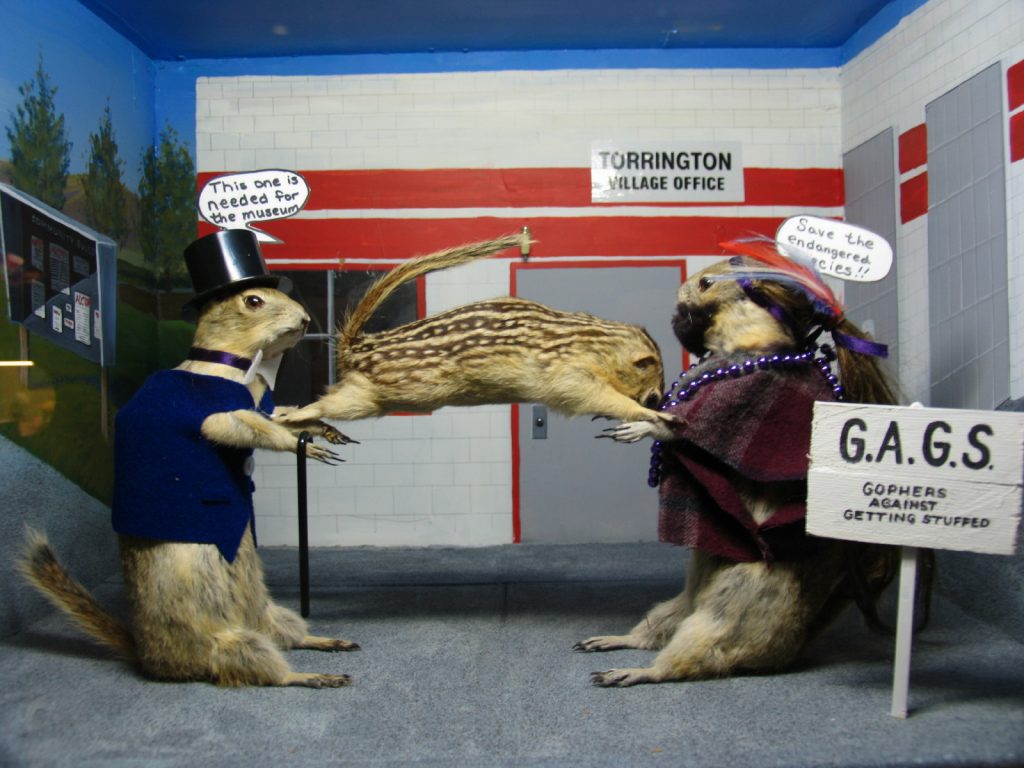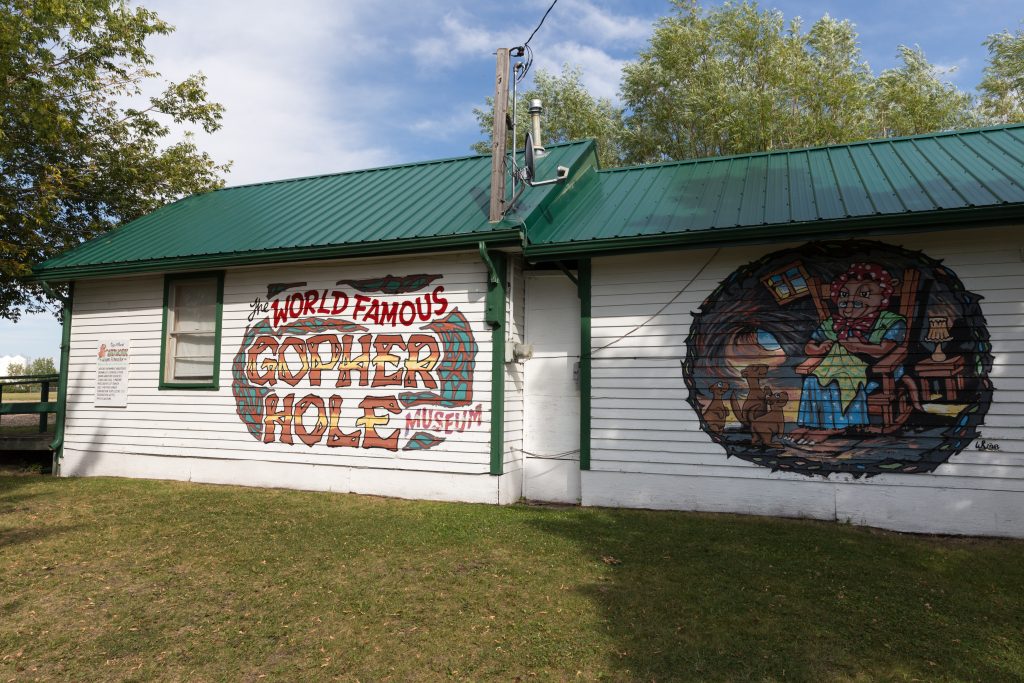The World Famous Gopher Hole Museum, Torrington, Alberta (1996—)
by Lianne McTavish

The Gopher Hole Museum is, indeed, world famous. Located in an isolated hamlet in southern Alberta, and open only during the summer months, the small museum attracts some 6,000 tourists per year, including many from outside of Canada. Since its foundation in 1996, the Gopher Hole Museum in Torrington has been featured in newspaper reports, award-winning films, documentaries, scholarly articles, and fan websites. Visitors navigate the back roads of rural Alberta to find the site. After paying the $2.00 entry fee, they walk through a darkened gallery to peer inside a series of colourful dioramas containing gophers—otherwise known as Richardson’s ground squirrels—that have been stuffed, clothed, and arranged to enact scenes of small-town life. Settings include Torrington’s former beauty parlour, pool hall, and diner, as well as its existing curling rink and playground. These representations are amusing, but they are also complex. The dioramas reshape conventional museum practices to challenge long-standing assumptions about the authority and educational function of museums. Taking the Gopher Hole Museum seriously is part of a broader movement in critical museum studies that turns away from an exclusive focus on large, urban museums to consider the contributions made by the grassroots museums found in many North American small towns and rural areas.
Debating gophers
The Gopher Hole Museum gained notoriety even before it officially opened. In 1995, representatives of People for the Ethical Treatment of Animals (PETA) sent letters of protest to the mayor of Torrington, asking that prefabricated models be used in the exhibits, instead of taxidermy gopher corpses. The museum organizers responded by sending PETA a card advising its members to “get stuffed.” The ensuing controversy attracted global media coverage, inspiring people from as far away as Germany and Japan to write letters both in favour of and in opposition to Torrington’s new museum. The diorama shown above commemorates this debate. Two gophers play tug of war with the body of a third animal. One of the two gophers, representing Torrington’s mayor, is dressed in conservative nineteenth-century garb such as a navy vest, bow tie, and top hat. He asserts, “This one is needed for the museum,” while battling his rival, a bearded “hippie” gopher adorned with a long ponytail and a purple poncho, who shouts, “Save the endangered species!!” The handmade sign beside the hippie gopher proclaims his affiliation with G.A.G.S., or Gophers Against Getting Stuffed. The hippie gopher attempts to take not only the animal that he grasps, but also the right to determine its meaning.
The local people who founded the museum, sourced both living and dead gophers, and made the diorama have insisted on their first-hand knowledge of gophers, arguing that the animals are far from endangered; in fact, they are abundant throughout the region, and regularly damage crops and livestock with their burrows. At the same time, the museum founders have displayed the protest letters alongside the G.A.G.S. diorama, allowing visitors to read them and make up their own minds about the issue. This openness is continued throughout the museum, which lacks explanatory labels or a unified narrative. Visitors participate in the production of meaning, while chatting with the friendly volunteer staff at the museum and taking as many photographs as they like. The Gopher Hole Museum embraces its role as a site of debate, sociability, and pleasure, at odds with the reserved and authoritative position often adopted in large, urban museums that aim to “improve” visitors.
Expanding the museum
“It’s not the Louvre!” This comment from a review on Tripadvisor warns visitors not to expect a grandiose structure filled with valuable art objects or archival documents when they encounter the Gopher Hole Museum. The unconventional museum was primarily designed to bring people into Torrington and bolster its economy. Despite lacking historically important artifacts, the museum preserves the rural heritage of the area by celebrating Torrington’s past as an active agricultural centre. Current and former residents of the region can recognize the historically specific details of almost every diorama. The dispute between the gophers takes place, for example, in front of the former Village Office as it looked from 1979 until 1997, when it was vacated because the town had dissolved into a hamlet. Although most of the buildings in the area, including the grain elevators portrayed in another diorama, are now demolished, they are playfully revived inside the Gopher Hole Museum alongside scenes of the community picnics, fashion shows, and yard sales that were held annually when Torrington was larger.
Outsiders may not be aware of the museum’s important role in the community. Some tourists initially perceive the displays as weird, strange, or quaint, reinforcing stereotypes that position rural people outside of modernity and progress. Yet many online reviewers of the Gopher Hole Museum appreciate the skill required to produce the dioramas, while admiring the adaptability and resilience of the people of Torrington. Although surprised by the exhibitions at the Gopher Hole Museum, most visitors embrace the opportunity to rethink the idea that museums should be filled with historic objects whose meanings are explained by professional scholars.

Natural history museums, gender, and the handmade
The Gopher Hole Museum is in some ways traditional, for it alludes to the early history of museums in Canada, informed by the colonial museum conventions largely developed in Europe and the United Kingdom. The taxidermy gophers recall the contents of the natural history museums that were established during the nineteenth and early twentieth centuries in cities and small towns. Self-trained museum founders sought to promote local resources by displaying taxidermy mammals and birds as well as insects, minerals, fossils, dried plants, and samples of lumber to the public. Such natural history museums often featured dioramas in which taxidermy animals were placed within recreated landscape settings designed to mimic nature. In contrast, the dioramas inside the Gopher Hole Museum anthropomorphize the stuffed gophers, portraying them as people within artificial rather than natural settings. The dioramas thus point to the deliberate reconstruction of nature, while suggesting that museums are also culturally produced, not monolithic organizations that present visitors with authoritative truths about the world.
The dioramas in Torrington were largely crafted by local women, a gendered aspect portrayed on the exterior signage of the Gopher Hole Museum, which shows a maternal gopher in the act of knitting. This hand-painted reference to a task traditionally associated with women invokes the role of women in the creation of early museums in Canada, including natural history museums. Female members of natural history societies participated in collecting and arranging museum display items and organized museum fundraising events. The Gopher Hole Museum continues this tradition by featuring in its gift shop the gopher costumes and other items handmade by local women. This content celebrates the skills and values of rural women, revealing their role in creating cultural organizations that sustain the community.
Conclusions
The Gopher Hole Museum in Torrington is inventive, funny, open-ended, and critically engaging. It challenges assumptions about what museums are and should become, while celebrating the knowledge and skills of the local people, especially rural women, who preserve the heritage of their town by reworking the history of early museums in Canada.
About the author
Lianne McTavish is Professor of the History of Art, Design, and Visual Culture in the Department of Art and Design at the University of Alberta. She offers courses in early modern visual culture and critical museum theory. Her research has been generously funded by, among other sources, the Social Sciences and Humanities Research Council of Canada (SSHRC) and the Killam Research Fund. McTavish has published many articles, edited collections, and has completed four single-authored monographs, including Defining the Modern Museum (University of Toronto Press, 2013) and Voluntary Detours: Small-Town and Rural Museums in Alberta (McGill-Queen’s University Press, 2021). She regularly curates exhibitions of contemporary art.
Further reading
Candlin, Fiona. Micromuseology: An Analysis of Small Independent Museums. London: Bloomsbury, 2016.
Bennett, Tony. The Birth of the Museum: History, Theory, Politics. New York: Routledge, 1995.
Furniss, Elizabeth. The Burden of History: Colonialism and the Frontier Myth in a Rural Canadian Community. Vancouver: UBC Press, 1999.
Lehrer, Erica, Milton, Cynthia E., and Monica E. Patterson. Curating Difficult Knowledge: Violent Pasts in Public Places. Houndmills: Palgrave Macmillan, 2011.
Levin, Amy. Defining Memory: Local Museums and the Construction of History in America’s Changing Communities. New York: Altamira Press, 2007.
Lowenthal, David. “Fabricating Heritage.” History and Memory 10, no. 1 (Spring 1998): 5‒24.
McTavish, Lianne. Defining the Modern Museum: A Case Study of the Challenges of Exchange. Toronto: University of Toronto Press, 2013.
McTavish, Lianne. Voluntary Detours: Small-Town and Rural Museums in Alberta. Montreal and Kingston: McGill-Queen’s University Press, 2021.
Phillips, Ruth. Museum Pieces: Toward the Indigenization of Canadian Museums. Montreal and Kingston: McGill-Queen’s University Press, 2011.
Smith, Laurajane. Uses of Heritage. New York: Routledge, 2006.
Wakeham, Pauline. Taxidermic Signs: Reconstructing Aboriginality. Minneapolis: University of Minnesota Press, 2008.
a three-dimensional recreation of a landscape or natural scene, popular in natural history museums during the late nineteenth and early twentieth centuries
Since the 1960s, scholars from various fields, including art history, sociology, anthropology, history, and museum studies, have questioned the authority and political neutrality of museums. Substantial literature examines how museums provide lessons in citizenship and nationalism while excluding working-class, racialized, and Indigenous peoples. Responses to such critiques expand the notion of what museums have been in the past and could become in the future, rethinking their educational function, social role, and political responsibility, including the obligation to display “difficult knowledge” related to oppression.
the art of preparing and mounting animal skins to create a lifelike effect
the values, identities, and practices inherited from the past. According to historian David Lowenthal, heritage is at odds with history because it is formed by hindsight to exaggerate positive elements of the past while omitting negative ones to create an affirmative account that reflects well on the people telling it.

